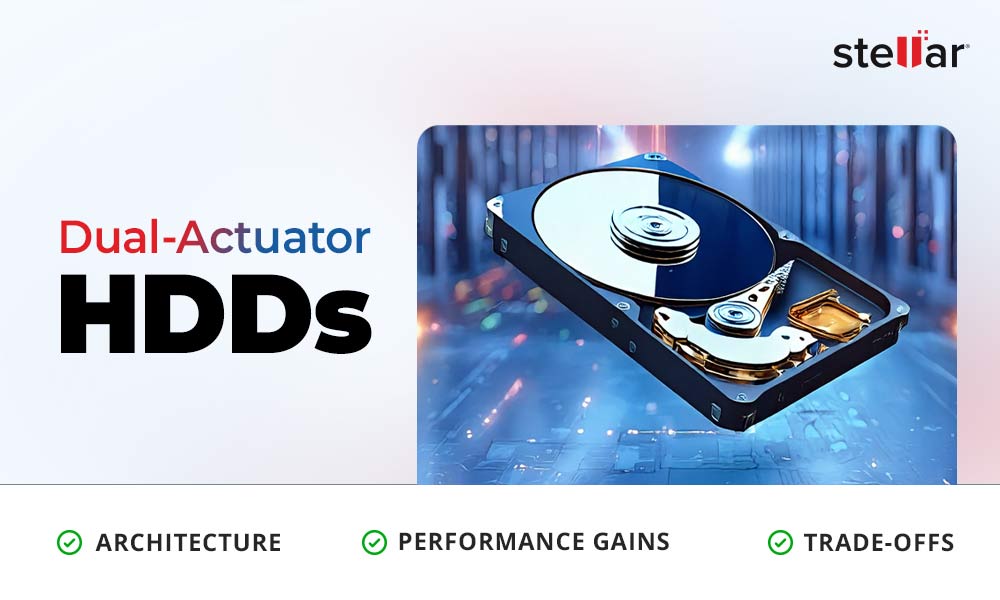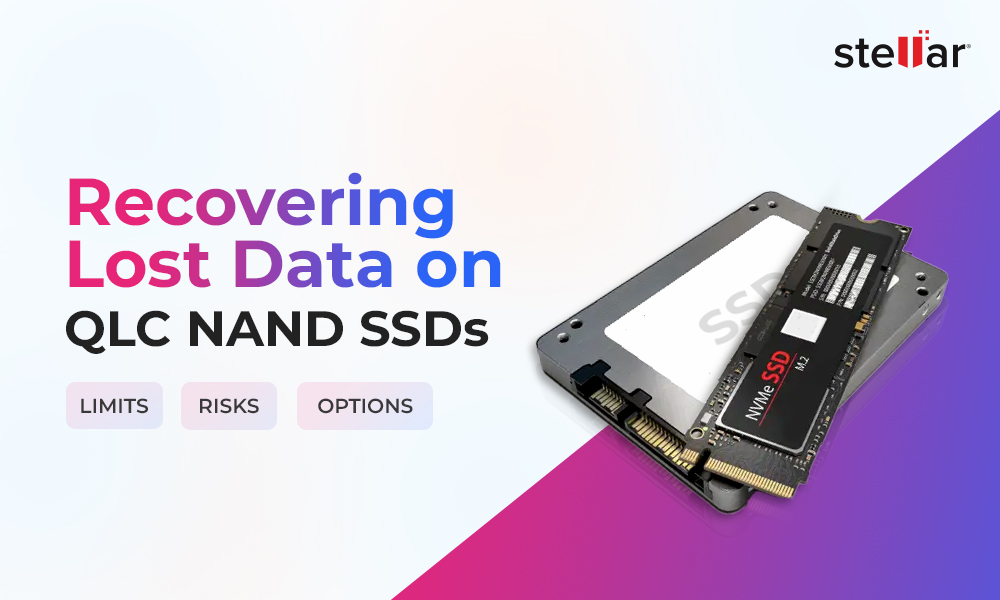Solid-state drives, or SSDs as we know them, have literally exploded in popularity lately and the SSD market is projected to exceed $125 billion by 2026. It is common knowledge that these modern SSDs almost universally use 3D NAND flash memory. This means that those 3D NAND stacks memory cells in vertical layers (imagine a tiny skyscraper of transistors) to pack in more capacity. This kind of architecture bolsters density and performance but it also changes the rules for data recovery. When those important files somehow get lost on a 3D NAND SSD, rescuing them can be trickier here than on any one of those older planar chips. Let’s explore why.
Why SSDs (in general) are harder to recover than HDDs
First thing to remember is that SSDs are totally different from hard drives. With an HDD, “deleted” data often just sits on spinning platters until it is somehow overwritten. SSDs on the other side use complex controllers and flash memory. They employ features that protect data but also hide it from prying eyes. For example:
- Wear leveling: SSD controllers spread writes evenly across all flash cells to prolong drive life. That’s great for durability, but it means pieces of a file can end up scattered all over the drive. In a recovery scenario, it’s like hunting for puzzle pieces in many locations instead of one.
- TRIM command: When you delete a file, the OS tells the SSD (via TRIM) to wipe those blocks for reuse. Unlike an HDD where deleted data lingers, an SSD may immediately erase the physical cells. In practice, that often makes deleted files irrecoverable, because the raw data is gone.
- Encryption: Many SSDs encrypt data on-the-fly with hardware keys. Without the original key (tied to the controller or user login), the bits in the NAND are unintelligible. In other words, even if you dump the raw cells, you see only gibberish.
- Controller failures: The SSD’s brain (its controller chip) manages everything. If it fails or its firmware gets corrupt, the drive can become inaccessible. Then you may need special tools or even chip-off techniques to read the NAND chips directly.
These are general SSD limitations (they apply to 2D or 3D NAND alike). But 3D NAND adds new twists on top of them. Most SSDs now use 3D NAND, so understanding these extra layers (literally) is key for recovery.
The 3D NAND architecture: Stacking cells for capacity
What exactly is 3D NAND? Traditional (“planar” or 2D) NAND arranged memory cells in a single layer on the silicon. Eventually, manufacturers hit a limit on how small they could make each cell. 3D NAND sidesteps that by building cells in vertical stacks. As one storage expert explains, 3D NAND is “stacked vertically using multiple layers to achieve higher density, lower power consumption, [and] better endurance”. This is why you see consumer SSDs of a few terabytes, and enterprise drives soaring past 10 TB in a 2.5″ chassis.
The trade-off is complexity. 3D NAND chips pack dozens or even hundreds of layers (Samsung and others already exceed 150 layers). Each layer has thousands of memory cells. Data is organized in pages and blocks as before but now there is a z-dimension of cells above and below. To deal with this, 3D NAND controllers use new schemes like Charge Trap Flash technology to build layers more reliably instead of that old floating-gate.
In short, 3D NAND lets SSDs hold far more data within the same space. But it also means signals have to travel differently, and errors can come from new directions. Those aspects make recovering data a more nuanced task.
Unique challenges with 3D NAND recovery
Modern SSD controllers hide most of the 3D NAND complexities, but for a data recovery specialist (or a savvy DIY-er), several challenges stand out. Key factors include:
- Vertical crosstalk (X, Y, Z interference): In planar NAND, interference mostly happens left-right or up-down (neighboring cells can disturb each other). With 3D stacking, cells above and below can also interfere. In practice, this means a bit pattern in one layer can nudge the charge levels of adjacent layers. Engineers fight this with data scrambling: for instance, bits are XOR’ed with a pseudorandom pattern before writing to break up problematic bit patterns.
In other words, 3D NAND needs specialized “scrambling” algorithms to decorrelate the data because of Z-axis interference. For recovery, it implies that raw bit values from a chip-off may need descrambling; one must know the right polynomial or LFSR scheme to reconstruct the user data.
- More bits per cell (TLC/QLC tech): To cram more data, it is important to know that many 3D NAND chips use triple- or quad-level cells (TLC = 3 bits/cell, QLC = 4 bits/cell). This implies that each cell’s voltage window will have narrower (more “levels” of charge to distinguish) and result in higher error rates. Generally speaking, MLC (2 bits) is more reliable than TLC which in turn is better than QLC.
Many first-generation 3D NAND SSDs used mostly MLC, which ironically gave them a lower bit-error rate than old planar TLC drives. But as 3D TLC/QLC becomes common, the error rates climb again – requiring stronger error correction. For data recovery, this multi-bit geometry means that “raw” charge readings are fuzzy without the controller’s context. You often have to emulate or reverse the exact mapping of charge levels to bits that the manufacturer’s firmware uses.
- Advanced ECC & read-retry loops: Because 3D NAND (especially TLC/QLC) produces more bit errors, the SSD uses very strong error-correcting codes (ECC). Modern drives use LDPC (Low-Density Parity-Check) codes, which can correct many errors but involve iterative soft-decision decoding. Reading a page might involve dozens of “read-retry” attempts at different reference voltages, each time applying ECC to see if the errors are fixable.
In plain terms, you can’t just dump a page once – the controller might try a series of voltage offsets to coax the data out. This adds headache for chip-off recovery: to read raw pages, one might need to replicate the drive’s LDPC algorithm and retry strategy (which are often proprietary).
- Vendor-specific commands and addressing: Unlike simple, standardized planar chips, 3D NAND controllers can use custom commands. For example, a chip might use extra address bits to select which layer to read, or special “set feature” commands to configure read voltages. Without documentation, these are mysteries.
A general-purpose NAND reader may not know how to talk to the chip or reach all its layers. In practice, that means a data recovery lab often needs either the original firmware or a specialized reader (like the “FlashReader” hardware some companies use scribd.com) to interact with a 3D chip.
- Wear-leveling & hidden remapping: All SSDs use wear-leveling (moving data around) and bad-block remapping. In 3D NAND, this is even more complex because there are more blocks and planes. This means the logical block numbers the OS sees may not match any fixed physical location. For recovery, one must rebuild the flash translation layer (FTL) map. Without the original controller logic, pages from one file might be scattered unpredictably. (This isn’t unique to 3D, but the many layers mean more pages to track.)
- Chip-off access difficulties: In extreme cases (firmware corruption, controller damage), data recovery might require removing the NAND chips and reading them directly (“chip-off” recovery). The Flash Memory Summit analysis flatly states that for SSD erasure verification or worst-case recovery, a “Chip-Off” approach may be the only way to recover data. However, the same source warns that 3D NAND “introduces new challenges for both reading and processing raw data” in chip-off scenarios. In other words, even if you physically grab the chips, you still have to deal with the above issues (LDPC, scrambling, weird pinouts, etc.) to interpret the bits correctly.
That’s a lot to digest! The key takeaway is that 3D NAND isn’t just a taller stack of cells – it comes with a taller stack of new technologies. Each layer of technology (literally and figuratively) can hide or scramble your data.
Recovering data: What you can (and can’t) do?
So how do these challenges affect you and me when we lose data? For many users, the first step is the same as always: don’t panic, don’t write new data to the drive, and try a recovery tool if it was a simple accidental deletion or formatting. Specialized software can often retrieve files before the controller has had time to TRIM or overwrite them.
For example, you can try a reliable Windows Data Recovery Software to recover lost data.
An ideal software should have the following features:
- Trial Scan Before Purchase: It should offer a free scan to show what can be recovered before you pay anything out of your pocket.
- Broad File System Support: It should work with NTFS, FAT32, exFAT, and other common formats for storage.
- Simple Workflow: It should ideally have a simple three-step process: Scan > Preview > Recover, which can be a bliss for non-experts.
- Automatic File Rebuilding: It should reconstruct metadata and fragmented files so recovered items are usable.
- Known Limitations: It should be effective for deletions, formats, and minor corruption (TRIM-erased or physically destroyed NAND excluded).
In contrast, severe hardware failures are beyond DIY. If an SSD has suffered controller burnout, firmware bugs, or physical damage, you’re usually looking at an expert lab. Professionals have "chip-off" stations and firmware repair tools to tackle those hardest cases. They can attempt to rebuild the drive’s translation map and emulate the controller’s behavior. But even they caution that 3D NAND requires support from the drive maker or advanced research; without it, chip-off recovery can get very expensive.
Conclusion
Recovering data from a 3D NAND SSD is a different ball game than an older HDD or even an older SSD. The vertical cell architecture, multi-bit cells, and controller tricks can literally make it harder for any software to read raw data directly. If you accidentally lose important documents or photos on a 3D NAND SSD, try a reputable Windows data recovery utility. These programs let you preview lost files before you buy, so you only spend money if your data really can be recovered. (They also support many file types and drive formats.) Finally, prevention is best: keep backups! Because if a 3D NAND SSD does fail or fully erase a block, even a genius in a lab might not be able to recover your data easily.













 9 min read
9 min read





